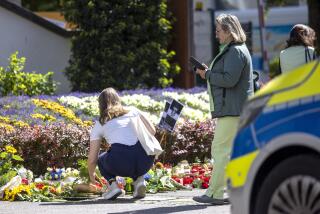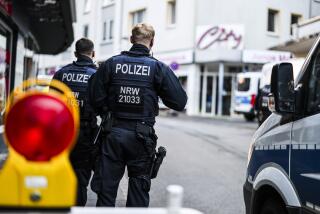Berliners Form ‘Chain of Light’ Against Racism
BERLIN — More than 200,000 people braved subfreezing weather to form a chain of light through this German city on Christmas night in the latest of a series of nationwide protests against right-wing violence.
Much like similar demonstrations held recently in other German cities, the Berlin protest had no official political backing. It was mainly a response to calls by the city’s major newspapers and radio stations for residents to come out and condemn the extremist attacks. The protest was also actively supported by churches and factories in the city.
Eberhard Diepgen, Berlin’s mayor, was present. Clutching a candle, he was but one link in a human chain that stretched more than six miles from the Lustgarten, at the center of what was once the government quarter in the former Communist east, through the Brandenburg Gate to a large square in the western district of Charlottenburg.
Police said there were no violent incidents or arrests linked to Friday’s demonstration.
In a country where many citizens believe their political leaders have failed to provide either answers or direction on vital national problems, the absence of official speeches or political party organizers is seen as a key reason for the large turnouts at street rallies against extremism.
The Berlin protest occurred on a day when President Richard von Weizsaecker said in a nationally televised holiday statement that the best cure for Germans’ feeling of estrangement from political leaders was to become personally active.
With the lone exception of Von Weizsaecker, Germany’s leadership for months seemed either unwilling or unable to react to the repeated attacks against foreigners. That inaction, coupled with the lack of any visible public response, generated an atmosphere of tacit approval for the attacks, which permitted a few thousand poorly organized, largely directionless youths to firebomb homes and hostels housing foreigners with seeming impunity.
Seventeen people have been killed and hundreds have been injured in the more than 2,000 violent incidents so far this year, mainly against foreigners; there also have been desecrations of Jewish cemeteries and memorials, giving the xenophobic violence anti-Semitic overtones.
The murder of three Turkish nationals in the northern town of Moelln on Nov. 23 seemed to shock both the public and the government into action. Earlier this month, more than 300,000 people turned out in Munich for an anti-violence demonstration, organized largely by four young Germans, including a local newspaper reporter, who specifically declined the support of political organizations. Last Sunday evening, almost a half million people took to the streets of Stuttgart, Bremen, Hannover and Karlsruhe with candles to form “chains of light” to protest racist attacks.
On Friday, despite the holiday and temperatures of just 18 degrees Fahrenheit, Berliners turned out in force to make the same statement.
“One Third Reich was enough,” said Christina Armbrecht, a western Berliner who held a candle near a major intersection in the western part of the city. She was accompanied by her husband and 12-year-old daughter.
Von Weizsaecker has consistently reminded Germans in recent speeches that the country’s first democratic experiment--the ill-fated Weimar Republic--collapsed in part because the public showed no real interest in its survival.
A woman in her mid-60s, carrying apartment keys in one hand and a small candle on a saucer in the other, said she came into the street because she believed it was necessary to show solidarity with the country’s non-German population.
Falko Bonte, a 16-year-old high school student, seemed to sum up the mood of many on the streets of the capital, saying: “It’s high time that we start to stand up for what we believe. It can’t be normal that my classmates are hassled in the subway just because they’ve got black hair and brown eyes. They were born in Berlin the same as I was.” Many Berliners of Turkish origin were born in the city.
In his television speech, Von Weizsaecker cautioned against trying to prevent the full integration of foreigners, many of whom have lived here much of their lives, into German society. He noted that one of the three Moelln victims, Yeliz Arslan, 10, had been born in the town, while another victim had lived there more than 20 years.
“In our media, however, they were just called ‘three Turks,’ ” he noted. “This language, oriented exclusively to a passport, suggests that they should stay foreigners. But, in fact, the three victims in Moelln really did belong to us.”
More to Read
Sign up for Essential California
The most important California stories and recommendations in your inbox every morning.
You may occasionally receive promotional content from the Los Angeles Times.










